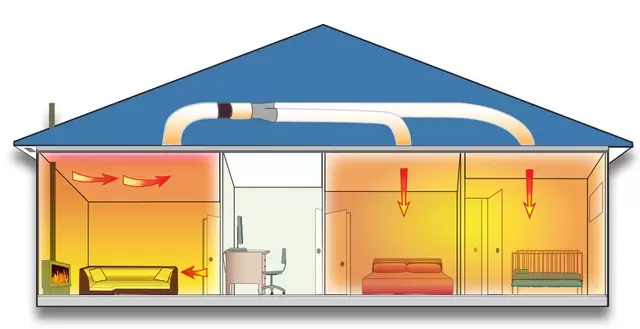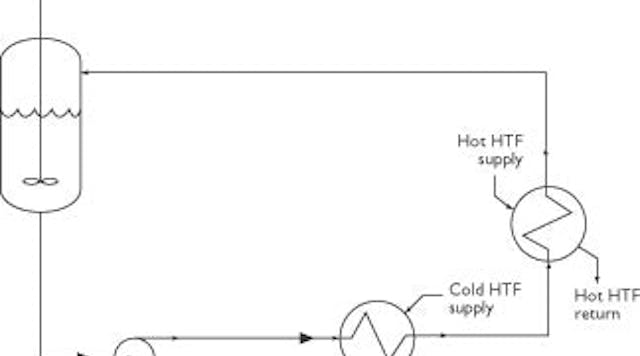How To Optimize Thermal Conductivity with DVS Heat Transfer Systems in Extreme Environments
Wiki Article
Exploring the Benefits and Applications of Heat Transfer Solutions in Modern Market
Heat transfer systems play a necessary duty in modern industry. They include various devices such as convection, conduction, and radiation, each adding to efficient thermal management. Industries like production and aerospace benefit greatly from these systems. As improvements proceed, the combination of innovative materials and modern technologies assures to boost energy effectiveness. This development raises important inquiries regarding the future implications for sustainability and functional expenses across several sectors. What lies in advance in this continuous change?Understanding Heat Transfer Principles
Heat transfer principles are basic to the procedure of different industrial systems. These concepts incorporate the devices of transmission, radiation, and convection, each playing an important duty in handling thermal energy. Comprehending conduction entails analyzing exactly how Heat relocates through strong materials, while convection refer to Heat transfer in fluids, driven by liquid motion. Radiation, distinctive from the various other two, includes power transfer via electromagnetic waves. The performance of Heat transfer impacts system efficiency, power consumption, and general performance. Effective thermal management is necessary in processes such as Heat, home heating, and air conditioning recuperation. By mastering these principles, markets can maximize their operations, reduce power costs, and enhance equipment durability, consequently adding to a more efficient and sustainable industrial landscape.Trick Types of Heat Transfer Systems
While various markets make use of Heat transfer systems for varied applications, numerous key types attract attention because of their details features and efficiencies. The most common types consist of convection, transmission, and radiation systems. Transmission systems transfer Heat with straight call in between materials, making them efficient in solid-state applications. Convection systems, on the other hand, utilize fluid movement to move Heat, appropriate for heating or cooling liquids and gases. Radiation systems run without a tool, relying upon electromagnetic waves to transfer Heat, suitable for high-temperature atmospheres. Each type serves distinctive objectives, enabling industries to tailor their Heat transfer options based upon functional needs, power efficiency, and cost-effectiveness. Understanding these systems is necessary for maximizing performance in different industrial settings.Industrial Applications of Heat Transfer Technologies
The application of Heat transfer innovations in industry plays an important role in boosting power effectiveness and optimizing procedures. DVS Heat Transfer Systems. By carrying out advanced Heat exchange systems, business can greatly lower their ecological influence while enhancing overall efficiency. This integration not just fosters sustainability however also lines up with modern governing and consumer needs for greener practicesPower Efficiency Improvements
As sectors progressively focus on sustainability, energy performance enhancements in Heat transfer innovations have actually become crucial for minimizing operational expenses and environmental effect. Boosted Heat exchangers, as an example, utilize advanced materials and layouts to make best use of thermal performance while decreasing energy intake. Integrating variable speed drives in pumping systems permits for much better control of liquid circulation, leading to significant energy savings. The application of wise sensing units and automation provides real-time monitoring, enabling modifications that optimize power usage. Furthermore, waste Heat recovery systems catch excess thermal power, transforming it into functional power. These advancements not only improve energy effectiveness however additionally add to a more sustainable industrial landscape by lowering greenhouse gas discharges and sustaining conformity with ecological policies.Refine Optimization Techniques
Process optimization methods are essential in improving the performance and performance of Heat transfer modern technologies in commercial applications. These strategies include refining procedures to make the most of Heat transfer performance while reducing energy consumption and functional costs. Methods such as computational fluid characteristics (CFD) modeling permit designers to examine and replicate Heat transfer scenarios, determining areas for improvement. Additionally, real-time surveillance systems can offer important data on temperature slopes and circulation prices, enabling changes that enhance performance. Moreover, executing innovative control approaches, such as anticipating analytics, can boost system responsiveness to varying operational needs. By using these optimization techniques, markets can attain higher thermal efficiency, lowered downtime, and enhanced product top quality, eventually bring about increased competition in the market.
Ecological Effect Decrease
While industrial Heat transfer innovations are essential for operational efficiency, their application also provides possibilities for considerable ecological impact decrease. By improving energy efficiency, these systems lessen gas usage, leading to lower greenhouse gas exhausts. Advanced Heat exchangers can recover waste Heat, redirecting it to preheat inbound liquids, thereby decreasing power demands. Web Site In addition, the assimilation Website of Heat transfer technologies in renewable resource systems, such as solar thermal and geothermal applications, sustains the change to lasting practices. Industries that employ these innovations additionally gain from reduced operational costs and improved regulative conformity. Generally, the tactical application of Heat transfer systems not just boosts productivity yet also fosters a much more sustainable commercial landscape, adding to worldwide environmental goals.Benefits of Efficient Heat Transfer Systems
Efficient Heat transfer systems use substantial benefits in modern industry, largely via boosted power performance and expense reduction. By enhancing thermal administration, these systems minimize energy waste, causing lower operational prices (DVS Heat Transfer Systems). Companies can accomplish greater sustainability and enhanced productivity.
Power Efficiency Improvements
As markets increasingly focus on sustainability and cost-effectiveness, energy performance improvements in Heat transfer systems have emerged as an essential emphasis. Boosted efficiency in these systems causes minimized power intake, allowing centers to operate more sustainably. By enhancing Heat transfer techniques, sectors can reduce waste Heat and accomplish much better thermal administration, significantly decreasing their environmental influence. Breakthroughs in modern technologies such as Heat exchangers and insulation materials contribute to enhanced performance and dependability. Applying energy-efficient Heat transfer solutions not just sustains conformity with regulatory requirements however likewise promotes a culture of advancement within companies. Ultimately, these renovations are important in aligning industrial operations with worldwide energy preservation goals, leading the way for a more lasting future in production and handling industries.Cost Decrease Opportunities
By enhancing Heat transfer systems, sectors can reveal substantial price why not look here reduction opportunities that boost their lower line. Effective Heat transfer reduces power usage, resulting in lower energy expenses and minimizing functional expenses. Additionally, enhanced system efficiency decreases the need for maintenance and fixings, furthermore conserving costs with time. Boosted Heat transfer can additionally extend devices life-span, allowing companies to delay capital investment on replacements. Waste Heat recuperation systems can change excess Heat right into useful energy, further driving down costs. These systems not only enhance procedures yet additionally contribute to sustainability initiatives, placing firms positively in an increasingly eco-conscious market. Generally, the monetary advantages of effective Heat transfer systems are necessary and considerable for competitive benefit.Advancements in Heat Transfer Solutions
Exactly how can contemporary sector enhance its procedures via innovative Heat transfer options? By taking on innovative products and modern technologies, sectors can considerably boost thermal performance and performance. Innovations such as nanofluids, which enhance Heat transfer capacities beyond conventional fluids, and phase change materials that save and release thermal energy, are obtaining grip. Furthermore, the integration of smart sensors and IoT gadgets enables for real-time tracking and optimization of Heat transfer processes, minimizing waste and boosting system responsiveness. Additive production methods enable the development of more complicated Heat exchangers that make best use of surface area while lessening material use. Jointly, these developments drive functional effectiveness and develop competitive advantages in numerous markets, consisting of manufacturing, energy, and aerospace.The Function of Heat Transfer in Sustainability Efforts
While the push for sustainability proceeds to reshape sectors, the role of Heat transfer technologies comes to be significantly essential in achieving environmental objectives. Efficient Heat transfer systems facilitate power effectiveness by optimizing thermal administration in various processes, significantly minimizing energy intake and greenhouse gas exhausts. Advanced Heat exchangers are used in commercial applications to redeem waste Heat, consequently reducing power waste. Furthermore, innovations such as stage adjustment materials enhance thermal storage, adding to renewable power assimilation. The fostering of lasting fluids in Heat transfer systems can decrease ecological influence. By prioritizing effective Heat transfer, industries not only enhance functional efficiency however likewise line up with global sustainability campaigns, promoting a cleaner, extra lasting future.Frequently Asked Inquiries
Just How Do Heat Transfer Equipments Impact Energy Costs in Manufacturing?
Heat transfer systems noticeably affect power prices in production by enhancing efficiency, minimizing waste, and enhancing thermal monitoring. These enhancements cause lower operational expenses, ultimately benefiting general performance and productivity in commercial operations.What Upkeep Is Needed for Heat Transfer Solutions?
Maintenance for Heat transfer systems consists of normal assessments, cleaning of components, examining liquid levels and conditions, replacing worn parts, and guaranteeing appropriate insulation. These activities enhance effectiveness, extend life-span, and prevent costly failures in procedure.Exist Security Issues With Heat Transfer Systems?
Safety and security worries with Heat transfer systems include possible leaks, pressure accumulation, and thermal risks. Appropriate layout, routine upkeep, and adherence to safety methods are necessary to minimize these risks and assure safe procedure in commercial environments.
Just How Can I Choose the Right Heat Transfer System for My Organization?
Choosing the ideal Heat transfer system involves assessing variables such as efficiency, application demands, spending plan constraints, and security criteria. A comprehensive evaluation of these elements will assist ensure perfect efficiency and reliability in company procedures.What Prevail Failings in Heat Transfer Systems and Their Causes?

Comprehending transmission involves examining how Heat moves via solid products, while convection pertains to Heat transfer in fluids, driven by fluid activity. By optimizing Heat transfer approaches, industries can decrease waste Heat and achieve better thermal management, significantly lowering their ecological impact. Waste Heat healing systems can change excess Heat into functional energy, better driving down prices. Advanced Heat exchangers are made use of in commercial applications to redeem waste Heat, thereby reducing power waste. Typical failures in Heat transfer systems consist of leaks, rust, and ineffective Heat exchange.
Report this wiki page